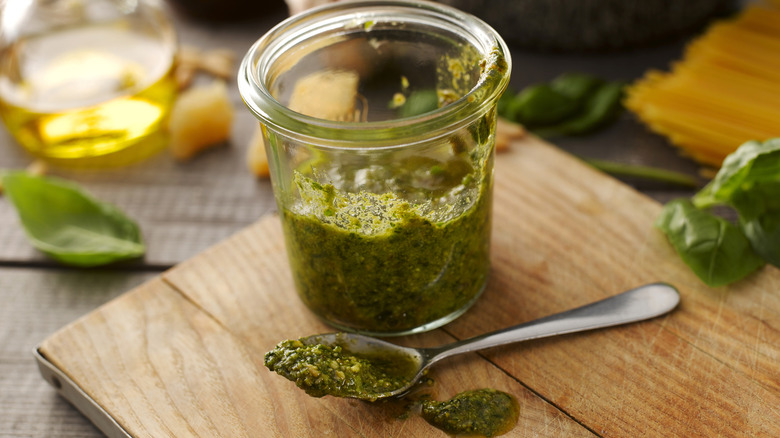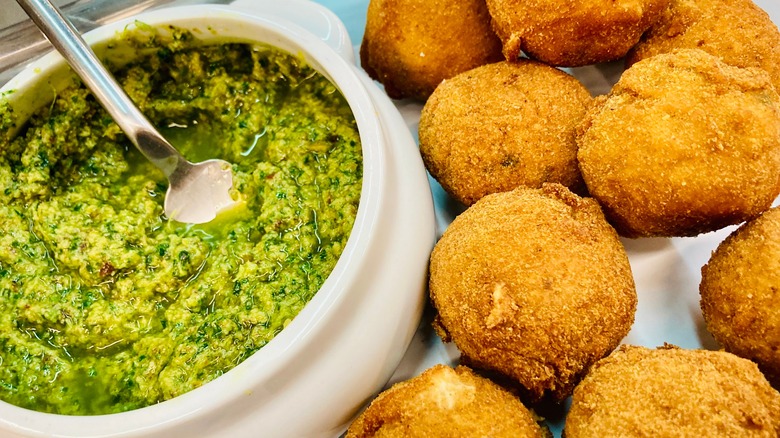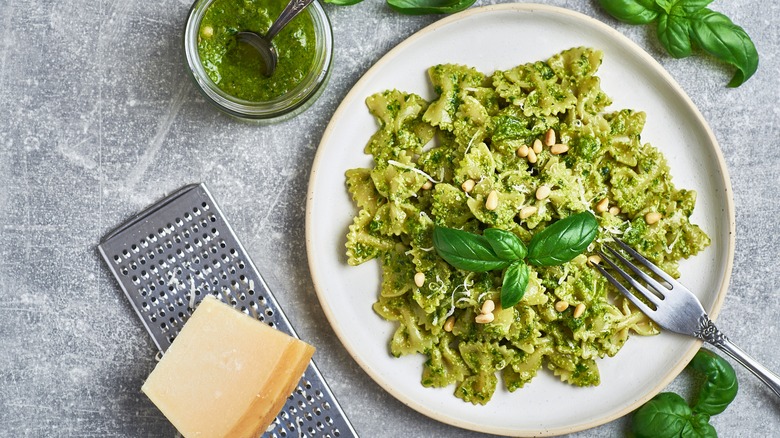Italian Salsa Verde Vs Pesto: How Do These Green Sauces Differ?
When you think of a green Italian sauce or condiment, your mind probably goes first to pesto. It is, after all, found on countless Italian and Italian-American restaurant menus and is considered one of the most popular pasta sauces in the world. But pesto isn't the only herbaceous green sauce that is popular in Italy and beyond. While it could be mistaken for pesto at first glance, Italian salsa verde has a very different flavor profile and comes from a different part of the country.
While pesto offers a creamy and rich flavor to dishes due to the presence of cheese and nuts, Italian salsa verde features salty umami flavors and zest thanks to briny ingredients like salt-packed anchovies and capers. Because of these different flavor profiles, the sauces are also used in slightly different ways, each complementing an array of Italian and international flavors. With both in your cooking repertoire, the possibilities are nearly endless, but first, you'll need the nitty gritty on how these sauces differ and the best ways to serve each.
A quick note: While Italian salsa verde is always green, as the name implies, pesto can also be red (in the case of pesto rosso), and may not include herbs at all. For the sake of simplicity, we'll mostly be talking about green pesto when comparing it with Italian salsa verde.
Italian salsa verde adds a zesty punch to rich dishes
You'd be forgiven for thinking that Mexican salsa verde is the only one on the block, but many cultures have a version of green sauce. Italian salsa verde is just as delicious and arguably even more versatile than its Mexican cousin. Where Mexican salsa verde is made with cilantro, tomatillos, and chiles, lending a spicy and tart flavor profile, Italian salsa verde tends more savory while maintaining a punch of zesty acidity.
It incorporates parsley, anchovies, capers, olive oil, garlic, and some sort of acid (typically vinegar or lemon juice), using a hard-boiled egg to bring everything together into a creamy consistency. While these ingredients serve as the base for Italian salsa verde, it is common to see variations in the recipe with additional herbs or the exclusion of anchovies (or you could always try some of our favorite anchovy substitutes if the tiny fish aren't your thing).
Italian salsa verde is a vibrant shade of green, but its flavor is much sharper than that of pesto, allowing it to complement rich dishes like our traditional cheesy arancini. It is also often used to top grilled or roasted meats and fish, to liven up starchy vegetables, and as a flavorful condiment for paninis and other sandwiches. Italian salsa verde was popularized in the Piedmont region of Italy (bordering the French and Swiss Alps), making it particularly well-suited to pair with the meats, cheeses, and white truffles that are common in the region.
Pesto's creaminess is ideal for pasta and vegetables
The word pesto comes from the Italian word "pestare," which means to crush or grind (often with a mortar and pestle). So technically anything that's crushed could be called pesto (including Italian salsa verde). That said, pesto alla Genovese is what we often mean when we refer to pesto. Just south of Piedmont lies the coastal region of Liguria, where you'll find the city of Genoa, the birthplace of pesto alla Genovese. Given the proximity of Liguria to Piedmont, it's unsurprising that pesto and Italian salsa verde share similar characteristics. Still, pesto is most commonly made with basil, in large part due to the abundance of the herb in the Liguria region.
Other common staples in pesto include pine nuts, cheese, garlic, and olive oil, which create a creamier, richer sauce than Italian salsa verde. This makes it well-suited to all kinds of pasta dishes as well as lighter fare like grilled meats and vegetables to contrast with the rich sauce. This is, however, just the beginning.
There are many unusual ways to cook with pesto that go far beyond pasta, meats, and veggies, such as mixing it with hummus or adding it to savory baked goods like biscuits and scones. Put a spin on the classic by using another ingredient in place of basil, like in our easy garlic scape pesto. Alternatively, try Sicilian pesto alla Trapanese, made with tomatoes and almonds, on your grilled cheese sandwiches.


